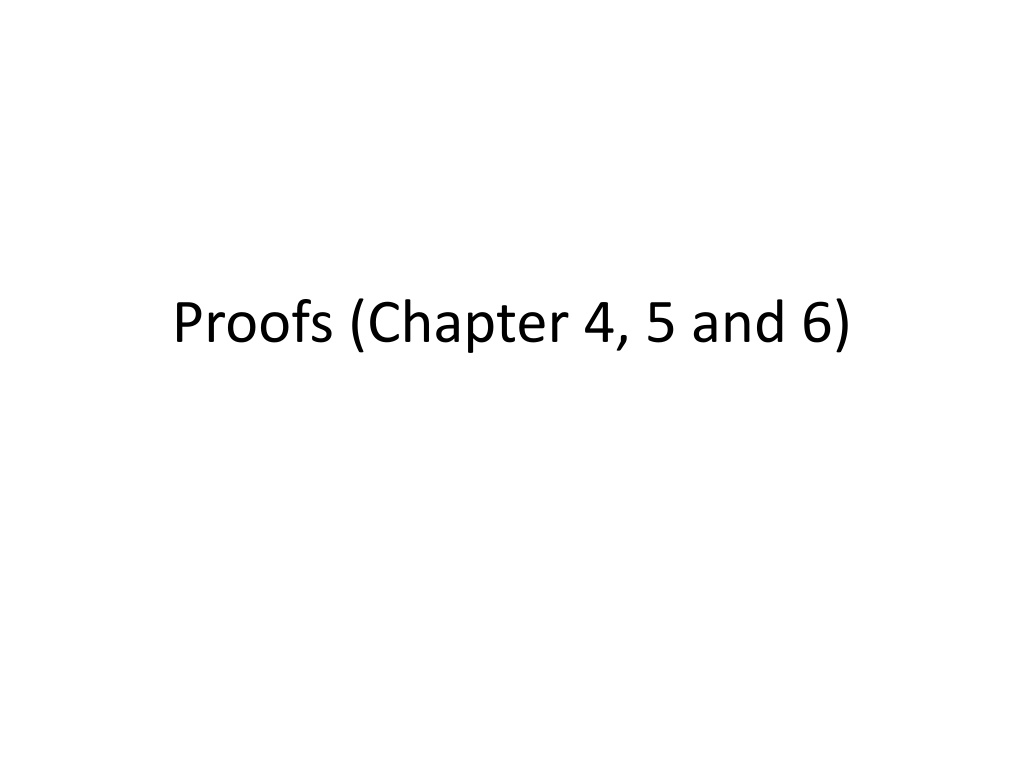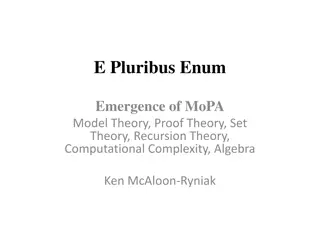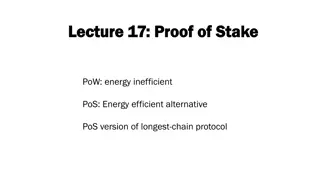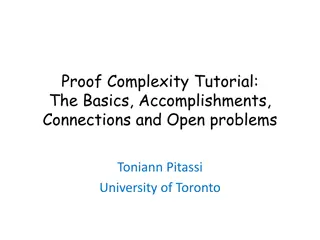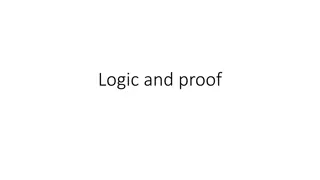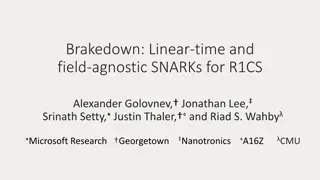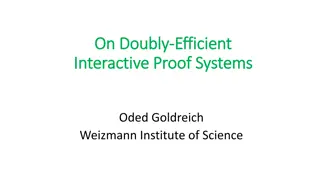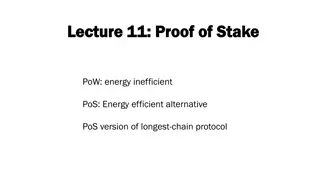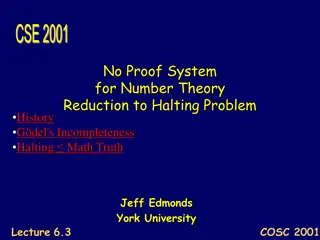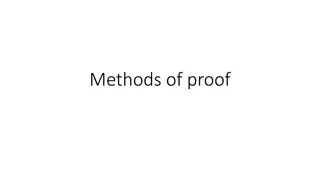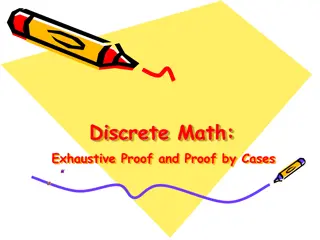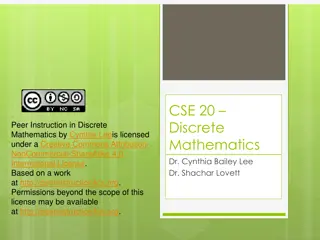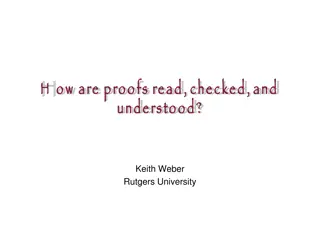Mathematical Proofs and Concepts
Explore the world of mathematical proofs through chapters 4, 5, and 6. Delve into terminology, theorems, definitions, divisors, and accepted axioms used in mathematical reasoning. Discover the logic behind proofs and various methods employed in establishing the truth of mathematical statements.
Download Presentation

Please find below an Image/Link to download the presentation.
The content on the website is provided AS IS for your information and personal use only. It may not be sold, licensed, or shared on other websites without obtaining consent from the author.If you encounter any issues during the download, it is possible that the publisher has removed the file from their server.
You are allowed to download the files provided on this website for personal or commercial use, subject to the condition that they are used lawfully. All files are the property of their respective owners.
The content on the website is provided AS IS for your information and personal use only. It may not be sold, licensed, or shared on other websites without obtaining consent from the author.
E N D
Presentation Transcript
Proofs A proof of a mathematical statement is logical argument which establishes the truth of a statement. We will cover a variety of methods of proofs. There are terms which we should know while proving things.
Terminology A theorem is a statement that can be shown to be true (via a proof). A proof is a sequence of statements that form an argument. Axioms or postulates are statements taken to be self evident or assumed to be true. A lemma (plural lemmas or lemmata) is a theorem useful within the proof of a theorem. A corollary is a theorem that can be established from theorem that has just been proven. A proposition that is true is usually a less important theorem. A conjecture is a statement whose truth value is unknown. The rules of inference are the means used to draw conclusions from other assertions, and to derive an argument or a proof.
Theorems: Example Theorem (Divisor theorem) Let a, b, and c be integers. Then If a|b and a|c then a|(b+c) If a|b then a|bc for all integers c If a|b and b|c, then a|c Corrollary: If a, b, and c are integers such that a|b and a|c, then a|mb+nc whenever m and n are integers By part 2 it follows that a|mb and a|nc. By part 1 it follows that a|(mb+nc). What is the assumption? What is the conclusion?
Definitions An integer n is even if n=2a for some integer a Z. A.n integer n is odd if n= 2a + 1 for some integer a Z. Two integers have the same parity if they are both even or they are both odd. Otherwise, they have opposite parity. Other definitions
Divisors Consider three integers a, b and c, a 0, such that b = ac. In this case we say that a divides b. We write a | b. We also say that b is a multiple of a.
Divisors (Examples) Which of the following is true? 12 | 12 13 | 0 0 |13 121 | 11 11 | 121
Accepted facts we will use as obvious (axioms): In algebra, a + b = b + a Laws of algebra Laws of set theory Laws of inference
Euclidean Geometry Points and lines are our universe. Definition: Two angles are supplementary if the sum of the angles is 180 degrees. Axiom: Given two points, there is exactly one line. Theorem: If the two sides of a triangle are equal, the angles opposite them are equal. Corollary: If a triangle is equilateral, it is equiangular.
Multiples of an integer How many positive multiples of 12 are less than 100,000? The number of such multiples is 100,000/12 which is 8333. In general, the number of t-multiples less than N is given by: |{m Z+ | t |m and m N }| = N/t .
The Division Algorithm Theorem: Let a be an integer and d a positive integer. Then there are unique integers q and r, with 0 r < d, such that a = qd + r. a is called dividend, d is called divisor, q is called the quotient, and r is called the remainder
Prime numbers Definition: A number n 2, is prime if it is only divisible by 1 and itself. A number n 2 which is not a prime is called composite. Numbers 2,3,5,7,11, are examples of prime numbers.
Greatest Common Divisor (gcd) Definition: The gcd of integers a and b, denoted gcd(a,b), is the largest integer that divides both a and b. gcd(18,24) = 6; gcd(10,9)=1; gcd(6,0) =6
Least Common Multiple (lcm) Definition: The lcm of non-zero integers a and b, denoted lcm(a,b), is the smallest positive integer that is multiple of both a and b. lcm(4,6) = 12; lcm(7,7)=7.
Comments Not all terms can be defined. We accept some ideas as being so intuitively clear that they require no definitions or verifications. We accept natural ordering of the elements of N, Z, Q and R. We also accept that for integers a and b, a + b Z a b Z ab Z.
Direct Proofs We are interested in proving an implication: P Q, i.e. if P, then Q.
Direct Proofs We are interested in proving an implication: P Q, i.e. if P, then Q. Consider the truth table of P Q: Our goal is to show that this conditional statement P Q is true.
Direct Proofs We are interested in proving an implication: P Q, i.e. if P, then Q. Consider the truth table of P Q: Our goal is to show that this conditional statement P Q is true. Since P Q is true, if P is false. Therefore, we need to show that P Q is true when P is true.
Direct Proof of P Q Outline of direct proof We use the rules of inference, axioms, definitions, and logical equivalences to prove Q.
Problem: Consider the following hypotheses (premises) More I study, more I know More I know, more I forget More I forget, less I know. Conclusion: Everyone who studies more knows less. s(x): x studies more; m(x): x knows more; f(x) : x forgets more ; l(x): x knows less In symbols x, [(s(x) m(x)) (m(x) f(x)) (f(x) l(x)) (s(x) l(x)]
Problem (contd.): Conclusion: Everyone who studies more knows less. s(x): x studies more; m(x): x knows more; f(x) : x forgets more ; l(x): x knows less In symbols x, [(s(x) m(x)) (m(x) f(x)) (f(x) Direct Proof: Let c be an arbitrary element of the universe (population). We need to show that s(c) s(c) is true. l(x)) (s(x) l(x)] l(c).
Problem (contd.): Conclusion: Everyone who studies more knows less. s(x): x studies more; m(x): x knows more; f(x) : x forgets more ; l(x): x knows less In symbols x, [(s(x) m(x)) (m(x) f(x)) (f(x) Direct Proof: Let c be an arbitrary element of the universe (population). We need to show that s(c) s(c) is true. s(c) m(c); m(c) f(c); f(c) l(c) l(x)) (s(x) l(x)] l(c).
Problem (contd.): Conclusion: Everyone who studies more knows less. s(x): x studies more; m(x): x knows more; f(x) : x forgets more ; l(x): x knows less In symbols x, [(s(x) m(x)) (m(x) f(x)) (f(x) Direct Proof: Let c be an arbitrary element of the universe (population). We need to show that s(c) s(c) is true. s(c) m(c); m(c) f(c); f(c) l(c) s(c) l(c) by the transitivity l(x)) (s(x) l(x)] l(c).
Problem (contd.): Conclusion: Everyone who studies more knows less. s(x): x studies more; m(x): x knows more; f(x) : x forgets more ; l(x): x knows less In symbols x, [(s(x) m(x)) (m(x) f(x)) (f(x) Direct Proof: Let c be an arbitrary element of the universe (population). We need to show that s(c) s(c) is true. s(c) m(c); m(c) f(c); f(c) l(c) s(c) l(c) by the transitivity x (s(x) l(x)) Universal generalization l(x)) (s(x) l(x))] l(c).
Proposition: x, if x is odd, x2is odd. We have the starting structure for an arbitrary element x of the universe: indicates the end of the proof
Proposition: x, if x is odd, x2 is odd. Using the definition of odd numbers we get
Proposition: x, if x is odd, x2 is odd. We are almost there:
Proposition: x, if x is odd, x2 is odd. The above proof can also be written as follows (x is an arbitrary element of the universe): P(x): x is odd (x=2a+1) (x=2a+1) (x2 =2(2a2+2a+1) +1) (x2=2b +1) Q(x2): x2 is odd Thus P(x) Q(x2) is true for an arbitrary x.
Show that 1+2+3+ + n =n(n+1)/2 We assume that n N. We write x = 1 + 2 + + n.
Show that 1+2+3+ + n =n(n+1)/2 We assume that n N. We write x = 1 + 2 + + n. x = n + (n-1) + + 1. (Commutative property)
Show that 1+2+3+ + n =n(n+1)/2 We assume that n N. We write x = 1 + 2 + + n. x = n + (n-1) + + 1. (Commutative property) 2x = n(n+1) (adding both the rows) x = n(n+1)/2
Q. 4(4): Suppose x, y are integers. If x and y are odd, xy is odd. Assume x and y are odd integers. Then x=2a + 1, and y=2b+1 for some integers a and b.
Q. 4(4): Suppose x, y are integers. If x and y are odd, xy is odd. Assume x and y are odd integers. Then x=2a + 1, and y=2b+1 for some integers a and b. As a result xy = (2a+1).(2b+1)=4ab + 2a +2b +1 = 2(2ab+a+b) +1 =2t+1 where t is an integer. Therefore, if x and y are odd integers, xy is odd. This completes the proof.
Q. 4(6): Suppose a,b,c are integers. If a|b and a|c, the a|(b+c). by definitions, a|b implies b=ad for some integer d. Similarly a|c imples c= af for some integer f.
Q. 4(6): Suppose a,b,c are integers. If a|b and a|c, the a|(b+c). by definitions, a|b implies b=ad for some integer d. Similarly a|c imples c= af for some integer f. We can now write b + c =a(f+d) = a.t, for some integer t. Therefore, by definition, a | (b+c).
Q. 4(12): If x R, and 0 < x < 4,
Q. 4(12): If x R, and 0 < x < 4, We can rewrite the above equation as 4 x(4-x). This is only possible if x(4-x) > 0. This is true since 0 < x < 4.
Q. 4(12): If x R, and 0 < x < 4, We can rewrite the above equation as 4 x(4-x). This is only possible if x(4-x) > 0. This is true since 0 < x < 4. Upon further simplification we get (x-2)2 0. Thus the above statement is true.
Proof by cases Sometimes it is easier to prove a theorem by breaking it down into cases and proving each case separately. It is a direct method of proving statements like p1 p2 . pn q is equivalent to proving (p1 q) (p2 q) (p3 q) . (pn q).
Example For any two reals x and y, show that|x+y| |x| + |y|. Proof by cases:
Example For any two reals x and y, show that|x+y| |x| + |y|. Proof by cases: (Case 1) x 0, y 0 Theorem is true since (x+y) = x + y.
Example For any two reals x and y, show that|x+y| |x| + |y|. Proof by cases: (Case 1) x 0, y 0 Theorem is true since (x+y) = x + y. (Case 2) x < 0, y 0 Theorem is true since |x+y| < max{|x|,|y|} < |x| + |y|
Example For any two reals x and y, show that|x+y| |x| + |y|. Proof by cases: (Case 1) x 0, y 0 Theorem is true since (x+y) = x + y. (Case 2) x < 0, y 0 Theorem is true since |x+y| < |y| < |x| + |y| (Case 3) x 0, y < 0 Very similar to the second case (Case 4) x < 0, y < 0 In this case |x+y| = |x| + |y|.
Example Problem: Let n Z Z. Prove that 9n2+3n-2 is even.
Example Problem: Let n Z Z. Prove that 9n2+3n-2 is even. Observe that 9n2+3n-2=(3n+2)(3n-1) n is an integer (3n+2)(3n-1) is the product of two integers Case 1: Assume 3n+2 is even 9n2+3n-2 is trivially even because it is the product of two integers, one of which is even Case 2: Assume 3n+2 is odd 3n+2-3 is even 3n-1 is even 9n2+3n-2 is even because one of its factors is even
Proof by cases In proving a statement is true, we sometimes have to examine multiple case before showing the statement is true in all possible scenarios.
Practice problems from the text: Chapter 4 3,5, 7, 9, 14, 18, 19, 20, 21, 22, 26
Congruence of Integers Definition: Given integers a and b and an n N, we say that a and b are congruent modulo n if a and b have the same remainders when a and b are divided by n. In other words, n | (a-b). We express a b (mod n) 9 1 (mod 4) 109 4 (mod 3) 14 8 (mod 4)
